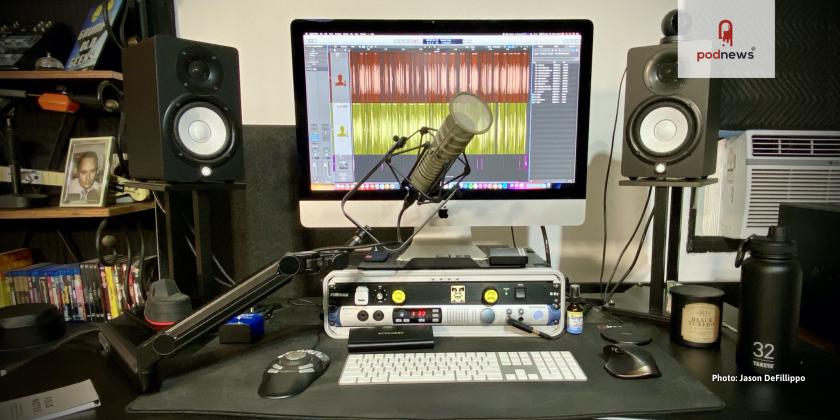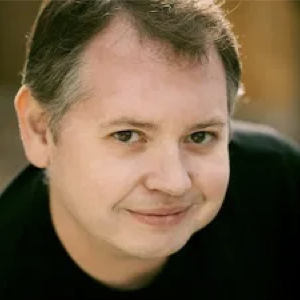
How I make... Grumpy Old Geeks

This article is at least a year old
A little over 7 years ago I got together with one of my oldest friends and started a podcast. We had a standing date once a month to complain about how hard it is to keep going in the tech business after you hit 40. Those conversations turned into the Grumpy Old Geeks podcast which has 460+ episodes and a few million downloads. This is a peek at how we currently make our show. It’s evolved greatly since we started and probably will continue to evolve but this is a peek at how we do it at this point in time.
Sound Conditioning: My studio is my garage. I recently had it insulated and drywalled to block out outside sound as well as insulated the garage door and hung several layers of moving blankets over it to squash as much street noise as possible. Over the 2 windows I’ve hung very heavy audio blankets to do the same. My co-host Brian Schulmeister records from his bedroom with zero audio treatment except there is a bed in the room that absorbs some reflections. Our other weekly co-host Dave Bittner records from a professional studio in Baltimore. Another co-host, Seth Miranda, records from his Brooklyn apartment with no audio treatment and an inordinate amount of trains running through his living room.
Microphones: I use an ElectroVoice RE-20 with a shock mount and pop filter. Brian records with an ElectroVoice RE-27N/D also with a shock mount and pop filter. Dave records with an Audio Technica AT3035 and Seth uses an Audio Technica AT2005. Brian and I also use Rolls MS111 mute switches and I have a Cloudlifter to add gain to my mic signal.
Audio Interface: I use 2 different interfaces currently. The main interface that I’ve used for 5 years is a Presonus Studio 192. I have it in a 2U rack mount briefcase so it’s portable, with a Furman rack mounted power conditioner that sits under my computer. My other interface that I use is a Sound Devices MixPre-6 II. I’ll eventually move all my operations over to the MixPre but for now I’m using a hybrid model depending on if I’m using my video station or my audio station to record. Brian uses a Sound Devices MixPre-6 I. Dave Bittner uses an Edirol UA-25 USB Capture Device and Seth Miranda goes straight to USB.
Computer: I have a loaded 2018 5K iMac, 64GB RAM, 4GHz Quad Core i7. Brian uses a new top of the line Macbook Air. Dave Bittner has a 5K iMac, 32GB RAM, 4GHz Quad Core i7. Seth Miranda has a loaded top of the line 16" Macbook Pro.
DAW: My DAW of choice is Logic Pro X. I’ve tried everything on the market for the Mac and for me Logic is the only way to fly. Beautiful interface (important for me) and an absolutely mind bogglingly huge feature set (which I use about 2% of) makes it a no brainer. Also it has a one-time purchase and works on all of my computers without any licensing issues or silly keys or dongles. I also use a little Mac app called Sound Studio as my Swiss Army knife for all small things as well as final MP3 exporting and ID tag editing.
Camera: We don’t use any cameras except for our live get togethers with the fans. We’re an audio only podcast and will remain that way until we close the doors on the show. Some faces are meant for podcasting and we definitely have those in abundance!
Media Hosting Company: Currently we have old episodes hosted on Libsyn so we don’t break the old website embeds or old links. Our main hosting provider is ART19. We decided to go with them because of their robust statistics (iAB 2 compliant) and their dynamic advertising system which lets us sell overflow spots and the back catalog. Over the years we’ve hosted with Squarespace, Blog Talk Radio, PodcastOne, SimpleCast, and Libsyn. For basic shows that just need basic, low-cost, and rock-solid hosting I recommend Libsyn. I do NOT recommend any service that will host your content for free and say they’ll make it up on ad sales for you. Those are usually fly by night and never last. Own your feed at all times!
Website: Gog.show is hosted on Wordpress.com for Business. We want to have the ability to use our own themes but also not want to worry about the day to day BS of keeping a Wordpress site up and secure. It’s pricey at $300 a year but it lets us sleep at night and not worry about getting hacked or our server going down and also gives us the flexibility and power of the Wordpress platform.
Other Software:
- Auphonic Leveler desktop version
- iZotope RX7 Advanced
- iZotope Neutron 3 Advanced
- iZotope Ozone 9 Advanced
- Waves Vocal Rider
- Audio Hijack
- Farrago
- Photoshop
- TextExpander
- BBEdit
- Reeder 3 & 4 (Mac and iOS)
- Quip
- Buffer
Pre-production: During the week my co-host and I scour through thousands of tech news articled (for me it’s usually about 4,000) looking to distill what the news is since the last show and what we can joke about or take the piss out of. We bring those headlines and links into Quip which is a collaborative editing system. We have pre-made templates for the shows that we duplicate and fill in based on which show it is. We do 2 episodes a week and together they make a whole. We used to do 1 2+ hour episode a week but we decided we need more advertising inventory and also 2 hour shows are tough for some people so we split the show. So our Wednesday and Saturday shows are vastly different. Anyway, we use Quip to store the stories and we then add bulleted talking points to each story for quick reference when we’re doing the show. We highlight the articles to show who’s the owner and main talker on that point. Quip isn’t cheap but it’s the best collaborative solution we’ve found after 7+ years of doing this. Each episode takes around 15-20 hours of prep per person.
Production: On show days we use SquadCast to record the remote sides. We ALWAYS run local backups of the show for every guest because some times the Internet just hates you. In the old days we used Skype with call recorder and double enders. Then moved to Zencastr but now we’re solidly in camp SquadCast. When the show is finally recorded we share all of our local recordings via Dropbox just in case I need them during the editing process.
Post-Production: Once the show is complete I grab all of the local WAV files from SquadCast and pre-process them in iZotope RX7 Advanced with a module set that I have for this particular show and for each participant since everyone needs a little bit of different love. Gain adjustments (I work at -6db and SquadCast does some in-house gain reduction so they need to be juiced a little) as well as De-click (for our friends with Misophonia out there) and some light Voice De-noise to clean things up.
After that part is done I bring everything into Logic. I have a template for the show so all of my bumpers are at the ready and all the appropriate filters have been applied to each track which reduces the time to edit the show. The filters I have set in Logic are Vocal Rider, Neutron 3 Advanced, and Ozone 9 Advanced for each guest. I have pre-sets for everyone so we sound the same from episode to episode.
During the editing I’ll add in the bumpers for each section as well as the intro and outro. Along the way I’ll find a break point to add in the ad drop. We don’t bake in the ads but use ART19's system to fill those in so I drop a marker for the ad spot that I’ll reference later and bake into the publishing system.
Since we’re a pretty tight show after 7+ years and almost 500 episodes there isn’t a lot of editing to be done anymore. Just tightening up the dialogue and removing any coughs or background noise and pauses between segments. The whole editing process takes about an hour or so.
I bounce the final file out of Logic and run it through Auphonic to get it to the -16 LUFS level and save the final in Sound Studio after adding the ID3 tags and artwork. The final is a 64 kbps / 44.1 kHz / Mono file encoded with CBR.
Back on Episode 374 I recorded the entire process for creating a show but we’ve updated a lot since then so there’s definitely been an evolution to our process.
Publishing & Distribution: Once the show is recorded Brian will create a short summary for me and the show art on the title we decide on. I take the text from the Quip doc and create the show notes from that with all the links to everything we discussed in the episode.
I manually create all those link in BBedit using some macros that I wrote to make the process faster but it’s all done by hand. Then I’ll create the show post in Wordpress, upload the show to Art19, add the tags for the ads and create the ads in their system if need be and schedule it for publishing on both platforms. The final step is to post the early release to our Patreon supporters in the ad-free form.
Brian will then create social posts for the various platforms that are scheduled to drop over the week using Buffer.
And in a nutshell that’s how we make an episode of Grumpy Old Geeks.































































































